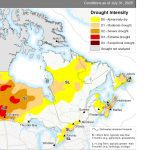Yield trending and cushioning could be among the program improvements next year at Saskatchewan’s crop insurance agency.
The two methods were recommended in a report to agriculture minister Bob Bjornerud from Meyers Norris Penny last week.
Officials are now analyzing the suggestions and costing them out.
Cam Swan, general manager of the Saskatchewan Crop Insurance Corp., said trending and cushioning are ways to deal with yield changes for different reasons.
Yield trending involves adjusting historical yields where there has been a significant yield shift due to technology. That could mean production technology or varieties.
Read Also

Alberta eases water access for riparian restoration
Alberta government removes requirement for temporary diversion licence to water plants up to 100 cubic metres per day for smaller riparian restoration projects
For example, herbicide tolerant canola, when first introduced, resulted in higher than expected yields.
Swan said the use of trending would incorporate that type of change to better reflect more recent experience and what future yields could look like, rather than rely on historical data.
The historical information would be multiplied by a factor to adjust the oldest information the most and the most recent information the least.
Alberta has used the method for two years. Swan said it would address the concern of insured yields being below expected yields.
Cushioning limits the effect of a bad year.
During the public consultation, some farmers wanted the ability to completely exclude a disaster year from their long-term individual average calculations.
The report instead recommends excluding yields below a fixed percentage of the expected yield, and stopping the loss at the fixed percentage.
Swan used the example of a 30-bushels-per-acre guarantee, and a fixed percentage of 70 percent.
If a crop yielded only 10 bu., that yield wouldn’t be factored into the long-term average because it is lower than 70 percent, or 21 bu., of the guarantee.
The idea is to keep a disaster from damaging yield history and result in lower coverage. That’s when producers often question whether they should purchase crop insurance.
“We see some real potential benefit to this,” Swan said, particularly in areas hit for a few years by flooding or drought.
He said changes like this have to meet a “probable yield test” to make sure crops aren’t overinsured.
The consultants’ report noted that producers who took part in the program review mistrusted existing yield methodologies and wanted a more responsive program.
“A perception exists amongst producers that the existing methodology results in a program where it is easier to lose experience discount credits than it is to build them,” the report said.
Bjornerud won’t announce until February whether these changes will be part of the 2009 program.
The report has 16 recommendations. Some are as basic as enhancing communication so farmers better understand crop insurance and continuing to evaluate new varieties for inclusion, while others are more complex.
Another recommendation is that the province reduce producer costs with respect to wildlife damage. It also suggested enhancing the weather-based programs by setting up more stations.

















